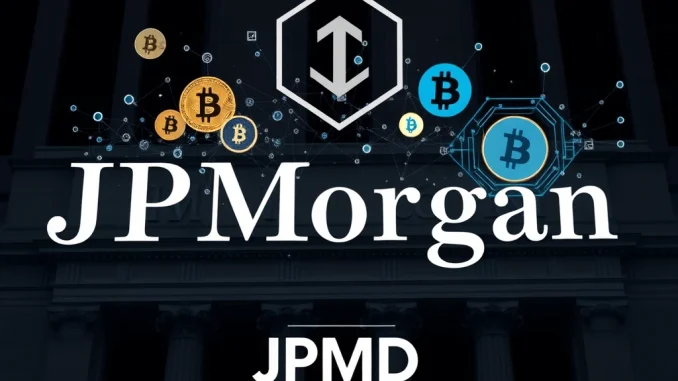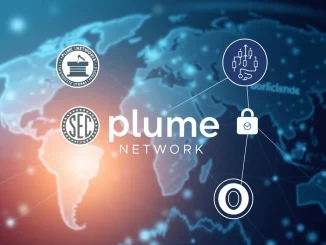
Big news is circulating in the financial world: JPMorgan, one of the largest banks globally, has reportedly filed a trademark application for ‘JPMD’. This development, shared by Unfolded on X, has ignited significant discussion among industry observers. Many are interpreting this move as a potential signal toward JPMorgan exploring or planning a new digital asset, possibly even a public-facing JPMorgan stablecoin.
What Does the `JPMD Trademark` Filing Mean?
A trademark filing is a legal step taken by a company to protect a brand name, logo, or slogan associated with specific goods or services. By filing for ‘JPMD’, JPMorgan is essentially reserving rights to this name for certain categories of products or services. While the filing details are not fully public, the context of JPMorgan’s prior work in blockchain and digital currencies suggests the ‘D’ in ‘JPMD’ likely stands for ‘Digital’ or ‘Dollar’, pointing towards a digital currency or payment system.
Industry analysts are quick to connect this filing to the bank’s ongoing efforts in the digital finance space. It’s a standard procedural step for any company looking to launch a new product or service under a specific brand name. The filing itself doesn’t guarantee a launch, but it certainly indicates that ‘JPMD’ is a name JPMorgan is considering or planning to use for something significant.
Could This Be a New `JPMorgan Stablecoin`?
The most popular interpretation of the ‘JPMD’ filing is the potential for a new JPMorgan stablecoin. JPMorgan is not new to the stablecoin concept. They already operate JPM Coin, a private, permissioned digital currency designed for internal use and facilitating wholesale payments between institutional clients on their private blockchain network, Onyx. JPM Coin is backed 1:1 by U.S. dollars held in designated accounts at JPMorgan Chase.
A ‘JPMD’ stablecoin could potentially represent an evolution or expansion of their digital currency strategy. Here are a few possibilities analysts are considering:
- A Public Stablecoin: Could JPMD be a stablecoin accessible beyond their private network, potentially competing with existing public stablecoins like USDC or USDT?
- An Expanded JPM Coin Offering: It might be a rebrand or expansion of JPM Coin services to a wider range of clients or use cases.
- A Tokenized Deposit System: Another possibility is a system for tokenized deposits, which are digital representations of traditional bank deposits on a blockchain.
Given JPMorgan’s focus on institutional finance, any potential JPMD stablecoin would likely target corporate clients, financial institutions, or potentially large-scale payment systems, rather than retail users initially. However, the trademark filing alone doesn’t specify the exact nature or target market.
The Rise of `Digital Assets` in Finance
JPMorgan’s exploration of ‘JPMD’ is part of a larger trend: the increasing adoption and integration of digital assets within traditional finance. Banks and financial institutions globally are recognizing the potential efficiencies offered by blockchain technology and tokenization.
Digital assets can represent a wide range of value, from cryptocurrencies like Bitcoin and Ethereum to tokenized versions of real-world assets like real estate, stocks, or even fiat currency (as with stablecoins and potentially Central Bank Digital Currencies – CBDCs). The move towards digital assets is driven by the promise of:
- Faster settlement times, especially for cross-border payments.
- Reduced costs by cutting out intermediaries.
- Increased transparency and auditability through blockchain ledgers.
- New possibilities for programmable money and financial applications.
The ‘JPMD’ filing fits squarely within this broader industry shift towards exploring and implementing digital asset solutions.
`Blockchain Finance`: Bridging Traditional and Digital
The concept of blockchain finance describes the intersection where traditional financial activities leverage distributed ledger technology. JPMorgan has been a prominent player in this space through its Onyx division, which focuses on blockchain-based solutions for wholesale payments, fixed income trading, and other financial services.
Using blockchain allows financial institutions to create more efficient internal processes and potentially offer new services to clients. A potential JPMD digital asset or stablecoin would be another building block in JPMorgan’s blockchain finance strategy, expanding their capabilities in digital payments and asset tokenization.
While cryptocurrencies like Bitcoin operate on public, permissionless blockchains, institutional blockchain finance often utilizes private or permissioned networks, offering more control and compliance features necessary for regulated financial activities. JPM Coin operates on such a network, and it’s plausible that ‘JPMD’, if it materializes as a digital asset, would also operate within a controlled environment, at least initially.
Navigating the Path for `Institutional Crypto`
The road for institutional crypto adoption is paved with both opportunity and challenges. JPMorgan’s potential ‘JPMD’ stablecoin or digital asset highlights the growing interest from major players, but also the hurdles they face.
Key challenges include:
- Regulatory Uncertainty: The regulatory landscape for stablecoins and other digital assets is still evolving globally. Banks need clear rules to operate confidently.
- Interoperability: Ensuring different blockchain networks and digital asset systems can communicate with each other is crucial for widespread adoption.
- Integration: Integrating new digital asset systems with existing legacy financial infrastructure is a complex task.
- Competition: The stablecoin market already has established players, and other financial institutions are also exploring similar initiatives.
Despite these challenges, the potential benefits of efficiency, speed, and new business models continue to drive institutional interest in the digital asset space. JPMorgan’s ‘JPMD’ filing is a tangible sign that major financial players are actively working towards a future where digital assets play a significant role in global finance.
Summary
JPMorgan’s trademark filing for ‘JPMD’ is a notable development, strongly suggesting the bank is planning a new digital asset initiative, potentially a new JPMorgan stablecoin. While details are scarce, the move aligns with the broader trend of traditional finance embracing digital assets and exploring blockchain finance solutions. As institutional crypto continues to evolve, filings like the JPMD trademark indicate that major players are actively positioning themselves in this transformative space. The coming months may reveal more about JPMorgan’s plans for ‘JPMD’ and its potential impact on the digital asset landscape.



